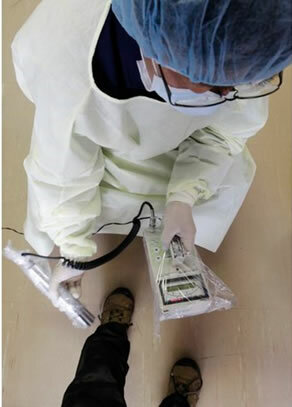German physicist Johannes Hans Geiger (1882-1945) was just assistant to New Zealand chemist Ernest Rutherford (1871-1937), when he invented the Geiger Counter – a device used to detect the level of radiation in the atmosphere.
In the beginning it was just a cylindrical tube with low pressure argon gas, an amplifier and a high voltage source.
The Geiger counter works as follows: when radiation enters the tube containing argon, this gas is ionized, as shown below:

Ionization of argon gas by radiation
When ionized, the argon closes the electrical circuit of the device, which is composed of electrodes with opposite electrical charges. With the formation of ions, electricity is conducted between the cathode and the anode, thus triggering a counter or loudspeaker. The signal that indicates the presence of radiation can be sound, a light or the deflection of the meter pointer. Normally, the counter clicks, which allows the counting of radioactive particles.
Nowadays, this device is a great ally for people who work with radioactive material; especially when nuclear accidents occur, as the substances that disintegrate are capable of ionizing the air and thus contaminating other bodies in the environment.

The Geiger counter is used to measure radiation levels.
By Jennifer Fogaça
Graduated in Chemistry
Brazil School Team.
Source: Brazil School - https://brasilescola.uol.com.br/quimica/contador-geiger.htm


